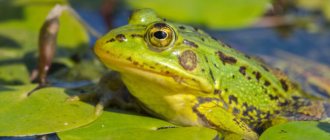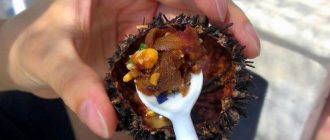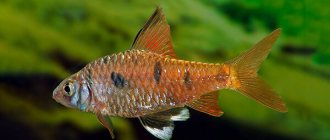Review author: “ZooVita”
The most ancient representative of the class of reptiles is the land turtle. An interesting fact is how long turtles live. The maximum age of land turtles is about 200 years, but the average reaches 30 years.
There is enormous variation in adult size within the population. Caring for a land turtle does not require special knowledge, which makes them popular for populating home terrariums.
General characteristics of the structure
The main anatomical feature of any of the existing subspecies is, of course, the shell. The original device performs a purely protective function. Its structure allows it to withstand significant overloads.
The shell consists of two layers that have anatomical features. The first layer consists mainly of horny scutes. The second component of the shell is the abdominal ribs, collarbone and sternum fused together. Also among the distinctive external features are:
- A small head with a streamlined shape, which allows you to quickly hide it in case of danger.
- Short neck.
- The eyes of land reptiles are always directed downward.
- Instead of teeth, there is a beak, with which turtles bite off and grind food. The inner surface of the beak is covered with an abundance of convex points, which replace teeth.
- The tongue is quite short, and turtles never stick it out.
- All representatives have a tail, sometimes with a spike at the end.
- All land turtles have developed color vision, which allows them to navigate in search of food.
- Among other sense organs, hearing is well developed.
Molting in land reptiles is simply the detachment of several horny scutes from the shell.
Habitat
Turtles are distributed everywhere. But it gives preference specifically to the steppe zone, for example, in the territory of Kazakhstan and China. You can find the land turtle in the semi-deserts of Africa, Australia, Italy and Greece.
Turtles dig shelters for themselves, where they spend most of their time. Reptiles leave their burrows only to search for food and water.
Diet in the wild
The diet of a land turtle contains mainly plant foods:
- Dandelions.
- Vegetables and greens.
- Young twigs and shoots.
- Grass.
- Some berries, such as strawberries.
For variety, reptiles may eat small insects, snails, slugs and worms. Mushrooms can be a valuable source of vegetable protein. Studying the basics of rational reptile nutrition will allow future owners to know what to feed land turtles.
Communication with land turtles
Turtles are very sociable animals.
They get used to their owner, distinguish him from other people, and generally behave much more intelligently than is commonly believed. Each turtle has its own character, its own inclinations and preferences, which the owner is often forced to take into account, and this is normal, considering that you are getting a turtle specifically for communication, as a friend. But we should remember that a turtle is still a wild animal that is not used to living in our apartments and constantly being in contact with people. This especially applies to animals that in the wild led a completely different way of life and were recently caught from the wild. Therefore, your main task as an owner is to carefully and carefully accustom the turtle to your presence and to new living conditions. From the very first day you should not actively play with her, hold her in your arms for a long time, etc. All this causes severe stress in the animal, which can affect its health.
When you buy a turtle, it is best to first place it in a pre-equipped terrarium and leave it alone. You will notice that she will actively move around her new home, exploring it and getting used to it. At first, food should be given carefully - you just need to put a bowl of food in the terrarium. Once the turtle gets comfortable and begins to eat normally, you can gradually begin to accustom it to handling.
At first, you should only gently touch it until you are sure that the turtle has stopped reacting negatively to your touch (sharply hiding its head, hissing, etc.). Then you can carefully pick her up. It is advisable that the turtle does not hang in the air for a long time without support under its feet. In such a situation, she feels extremely insecure and may be scared. Place her on your lap or on your hand. Gradually, these manipulations can be carried out more and more often, and soon the turtle will get used to them, will perceive them calmly and even with pleasure. Having become accustomed, these animals often strive to communicate themselves - they run up to the glass when they see a person, try to get out of the terrarium, etc.
By taming a turtle and becoming attached to it yourself, you risk going to the other extreme. Many loving owners, having discovered what an intelligent and interesting animal they have, begin to uncontrollably pamper their turtle. It soon becomes clear that the pet eats only one type of food, and only from hand, and even at a specific period of time!
Remember: these animals can be very capricious and capricious, they can even throw real tantrums and bite if they don’t like something. Don’t think that it’s just the turtle’s character, no. It was you who spoiled her. Even if we ourselves agree to endure all the whims of our pet out of love for him, unfortunately, sooner or later such a situation can greatly harm the turtle. An animal accustomed to constant attention may experience severe stress if you suddenly leave somewhere and he remains alone for a long time; in addition, even relatively simple manipulations with it, for example, giving medicine or feeding, will cause problems. Therefore, we do not recommend pampering an animal, even if you really want to do it.
So, the two main problems that arise in such animals and are harmful to their health are the refusal to stay in their terrarium (especially when there is someone at home) and an addiction to one type of food to the detriment of others.
In the first case, you should not pick up the turtle or release it from the terrarium at its request, so as not to develop a conditioned reflex in it. In the second case, you cannot feed the turtle by hand and offer the same food, and even separately. The turtle should receive a varied and properly selected diet.
Those foods that they choose for themselves as their favorite can often turn out to be far from the most useful. Therefore, you should not follow your pet’s lead. Arguments like “she loves it very much”, “she asks for it all the time” or “we feel sorry for her and we cannot refuse her” should not be decisive in this case. If the turtle refuses to eat what you offer it, simply remove the feeder and repeat this manipulation until the animal understands that it will not get its way anyway.
Don't worry about the turtle, it won't starve to death. These animals may not eat for several months in a row without any damage to their health, so there is no need to feel sorry for them in this case.
The same can be said about hand feeding. Having taught your turtle to eat only from your hands, you will subsequently be forced to do this all your life, but normal healthy land turtles live for a long time - about 60 years. Besides your own inconvenience, first of all, it is very harmful for the animal itself. So make communication with your pet fruitful for both parties, and then both you and your turtle will receive only joy from communication.
Main types of turtles
Based on the structural features of the neck and the nature of its hiding under the shell, turtles are divided into two groups:
- Representatives of the first group hide their heads in the direction of their paws.
- The second group is distinguished by the S-shaped folding of the neck.
Depending on their habitat and a number of phenotypic characteristics, the following types of land turtles are distinguished:
- Elephant turtle.
- Egyptian tortoise.
- Land Central Asian tortoise.
- Panther turtle.
- Speckled cape reptile.
Each of the presented species has its own characteristics, by which they can be easily recognized.
Arrangement with vegetation
In order for the home to be safe for the life of a turtle, it is necessary to know its breed and what natural conditions are inherent in it. Stones and plant roots should be placed so that your pet can easily walk around them or, if desired, climb on them.
The corners of a terrarium for reptiles are shelters in which they rest, so it is not necessary to place any vegetation there. This is usually done for the purpose of decoration with such safe flowers as sheflera, aechmea, sansevieria, guzmania and aloe.
It is best to place the plants in pots and cover the ground with stones so that the turtle does not get to the roots. Climbing plants also look impressive.
Don't forget about the safety of the animal. To do this, you need to avoid poisonous flowers, do not spray them with pest control products, and securely hide wires (for example, lamps and heaters) from the turtle so that it does not bite or scratch them.
Egyptian tortoise
This reptile is the smallest representative of land turtles. The length of the shell reaches only 13-14 cm. The color of the stratum corneum is presented in sand tones. Sometimes there are inclusions of black color.
Near the hind legs there is a strong elastic ligament, which allows the tail and limbs to be covered with a shell in case of danger. For females, the presence of a ligament is an advantage, because it allows them to lay fairly large eggs.
Panther turtle
The shell of representatives of this species can reach a length of 50 cm. A distinctive feature is the dome-shaped shell with an original pattern on a yellow background.
As the reptile grows older, the pattern becomes more pronounced, and all the relief lines become broken, which makes it possible to approximately determine the age of the individual.
Reproduction
To breed a Central Asian tortoise, you will need a pair - a male and a female - of approximately the same weight and age. The sexually mature age of a female is 10-12 years, for a male - from 5-6 years.
The mating period is February–August. The male approaches the female and, stretching his head forward, begins to hit her side with his shell, while making a dull clicking sound.
Since males become more aggressive towards each other, it is not recommended to keep two males in the same terrarium.
The female's pregnancy lasts 2 months. There are 2-6 eggs in a clutch. Incubation lasts from 60 to 65 days at a temperature of 28-30°C.
It has been noted that at low temperatures, a predominant number of boys may appear, and at higher temperatures, girls may appear.
The Central Asian land tortoise is a beautiful and graceful animal in its own way, requiring affection, skillful handling and proper care. After watching her, you will understand that behind her slowness lies the wisdom that many of us lack. After all, in a constant rush, we forget the main thing - to rejoice and enjoy life. Maybe this particular pet will make you think that you should stop and look at the world with completely different eyes.
Features of organizing home terrariums
Keeping reptiles in an apartment is not uncommon today. Caring for a land turtle at home includes the following items:
- Maintaining a certain temperature regime in the aquarium and maintaining humidity at the proper level. To do this, install two alcohol thermometers in the terrarium.
- Pets are given a daily bath with a warm soda solution.
- Periodically shorten the turtle's claws using a nail file.
- In the autumn-winter period, you should compensate for vitamin D deficiency using an ultraviolet lamp.
- The bottom of the aquarium is covered with soil so that the pet can dig holes without hindrance.
At the bottom it is better to place stones or a house that will serve as a shelter for the reptile. Food corresponding to the diet of turtles is cut into small pieces and placed on a shallow saucer.
Varieties
Land turtles are a fairly large family of the turtle order, which includes 16 genera and about 50 species. Among those living on land, the following are the most popular and well known.
Central Asian steppe tortoise
The turtle has a yellowish-brown color with fuzzy dark spots. The shell is low and round in shape, measuring 15–20 cm. There are 4 toes on the forelimbs. Puberty occurs at 10 years of age. Distribution area: countries of Central Asia, Iran, India, Afghanistan. This is the most popular type for keeping at home. With good care they can live for 30 years or more.
Mediterranean turtle
Other names: Caucasian, Greek. The color palette of the carapace contains olive, yellow and brown, and black spotty inclusions may be observed. The shell is high, the size of an adult turtle is 28 – 35 cm.
Distribution area: Southern Europe, South-West Asia, North Africa. Suitable for home use. It is best to buy an adult, as young turtles do not tolerate relocation well.
Land leopard (panther) tortoise
The turtle is sandy yellow in color with a dark brown spotted pattern. True to its name, its color resembles that of a leopard. The turtle is quite large, 70–80 cm, with a dome-shaped shell.
Distribution area: Africa. For this species, the terrarium must have a pond. Lives at home for 50 years or more. It eats only grass.
Egyptian land tortoise
It has a yellow-brown color. One of the smallest of the land turtles. The size of males does not exceed 10–12 cm, females are slightly larger.
Distribution area: Middle East and North Africa. When kept at home, the temperature in the terrarium should not fall below +24–25°C. In case of danger, the turtle quickly buries itself in the sand.
Balkan tortoise
The turtle's shell is yellow-brown with black spots on it. The carapace dimensions are 15–20 cm. This species has a long tail with a conical spike at the end.
Distribution area: Southern Europe. Life expectancy in natural conditions exceeds the 90-year mark.
Star turtle
A very beautiful turtle. The color of the carapace is dark brown or almost black, on which there are star-shaped spots of yellow color. The carapace is strongly convex, oval in shape, 15–25 cm long.
Distribution area: India, Sri Lanka, Pakistan. Suitable for keeping in captivity, will decorate any terrarium, life expectancy is 80 years.
Elephant (Galapagos) tortoise
The largest of the land turtles, its length reaches 180 cm, and its weight is 400 kg or more. They live more than 150 years, including in captivity. The brown-black shell of turtles living in highlands is dome-shaped, while that of turtles living in lowlands is saddle-shaped.
Distribution area: Galapagos Islands.











